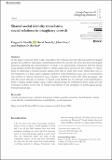Files in this item
Shared social identity transforms social relations in imaginary crowds
Item metadata
| dc.contributor.author | Neville, Fergus G. | |
| dc.contributor.author | Novelli, David | |
| dc.contributor.author | Drury, John | |
| dc.contributor.author | Reicher, Stephen D. | |
| dc.date.accessioned | 2020-08-06T15:30:02Z | |
| dc.date.available | 2020-08-06T15:30:02Z | |
| dc.date.issued | 2020-08-05 | |
| dc.identifier | 268334749 | |
| dc.identifier | ed36d78d-635d-4066-a32b-f8c9191beb39 | |
| dc.identifier | 000556845800001 | |
| dc.identifier | 85082740514 | |
| dc.identifier.citation | Neville , F G , Novelli , D , Drury , J & Reicher , S D 2020 , ' Shared social identity transforms social relations in imaginary crowds ' , Group Processes and Intergroup Relations , vol. Online First . https://doi.org/10.1177/1368430220936759 | en |
| dc.identifier.issn | 1368-4302 | |
| dc.identifier.other | ORCID: /0000-0001-7377-4507/work/78528507 | |
| dc.identifier.uri | https://hdl.handle.net/10023/20418 | |
| dc.description | This research was supported by ESRC Postgraduate Studentships for the first (PTA-030-200600100) and second authors (PTA-031-200500096), and an ESRC research grant for the third and fourth authors (ES/N01068X/1). | en |
| dc.description.abstract | In this paper we present three studies that address the difference between physical and psychological groups, the conditions which create a transformation from the one into the other, and the psychological processes underlying this transformation. In Study 1 we demonstrate correlations between shared social identity, desired physical proximity to others and positive emotions in the company of others. Study 2, employing a between-subjects design, finds that an event which creates shared fate, such as the breakdown of a train, leads to greater comfort in social interactions (e.g. ease of conversation) and comfort in sensual interactions (e.g. tolerance of the physical touch) with other passengers, and that this occurs through an increase in shared social identity but not through social identification. Study 3 obtains similar findings using a within-subjects design. In combination, these studies provide consistent evidence for the role of shared social identity in the emergence of psychological from physical groups. | |
| dc.format.extent | 16 | |
| dc.format.extent | 255050 | |
| dc.language.iso | eng | |
| dc.relation.ispartof | Group Processes and Intergroup Relations | en |
| dc.subject | Shared identity | en |
| dc.subject | Social identity | en |
| dc.subject | Crowds | en |
| dc.subject | Group behaviour | en |
| dc.subject | Social identification | en |
| dc.subject | Social interaction | en |
| dc.subject | Intimacy | en |
| dc.subject | Intragroup relations | en |
| dc.subject | Positive emotions | en |
| dc.subject | Group processes | en |
| dc.subject | Shared social identity | en |
| dc.subject | BF Psychology | en |
| dc.subject | Social Psychology | en |
| dc.subject | Organizational Behavior and Human Resource Management | en |
| dc.subject | NDAS | en |
| dc.subject.lcc | BF | en |
| dc.title | Shared social identity transforms social relations in imaginary crowds | en |
| dc.type | Journal article | en |
| dc.contributor.sponsor | Economic & Social Research Council | en |
| dc.contributor.institution | University of St Andrews. School of Management | en |
| dc.contributor.institution | University of St Andrews. School of Psychology and Neuroscience | en |
| dc.identifier.doi | 10.1177/1368430220936759 | |
| dc.description.status | Peer reviewed | en |
| dc.date.embargoedUntil | 2020-08-05 | |
| dc.identifier.grantnumber | ES/N01068X/1 | en |
This item appears in the following Collection(s)
Items in the St Andrews Research Repository are protected by copyright, with all rights reserved, unless otherwise indicated.

